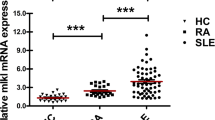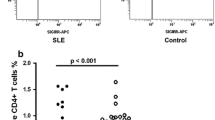Abstract
Purpose
Growth arrest-specific protein 6 (Gas6) has been suggested to be a biomarker of disease activity in patients with systemic lupus erthematosus (SLE). We investigated the clinical significance of this protein in Korean SLE.
Methods
Blood samples were collected from 150 SLE patients and 50 normal controls (NC). In addition, follow-up samples were collected from 50 SLE patients.
Results
Serum Gas6 levels of SLE patients (43.01 ± 28.02 ng/mL) were higher than those of NC (20.15 ± 9.23 ng/mL, p < 0.001). When evaluated sensitivity and specificity of the Gas6 for diagnosing SLE using ROC curves, the sensitivity and specificity were 72.7 % and 84 % with a cut-off value of 25.3 ng/mL. In the ROC analysis of Gas6, anti-dsDNA antibody, ESR, complement 3 and complement 4 to identify patients with active lupus, area under the curve (AUC) of Gas6 was highest with 0.763. Serum Gas6 levels were significantly higher in the patients with serositis (70.04 ± 30.85 ng/mL) and renal disorder (65.66 ±32.28 ng/mL) compared to those without (41.88 ± 27.44 ng/mL, p = 0.033, 40.3 ± 26.33 ng/mL, p = 0.001, respectively). Gas6 levels were correlated positively with anti-dsDNA antibody (r = 0.199, p = 0.015), ESR (r = 0.204, p = 0.013) and SLEDAI (r = 0.512, p < 0.001). In addition, serum Gas6 levels were correlated negatively with hemoglobin (r = −0.165, p = 0.043), lymphocyte count (r = −0.165, p = 0.043), complement 3 (r = −0.343, p < 0.001) and complement 4 (r = −0.316, p < 0.001). Furthermore, change in serum Gas6 levels was correlated with change in SLEDAI levels in the SLE patients that were followed up (r = 0.524, p < 0.001).
Conclusion
These results suggest that serum Gas6 can be a reliable clinical marker for monitoring disease activity and treatment response in SLE.




Similar content being viewed by others
Abbreviations
- ACR:
-
American College of Rheumatology
- anti-dsDNA:
-
Anti-double stranded DNA
- BILAG:
-
British Isles Lupus Assessment Group
- ESR:
-
Erythrocyte sedimentation rate
- Gas6:
-
Growth arrest-specific protein 6
- NC:
-
Normal controls
- SLE:
-
Systemic lupus erthematosus
- SLEDAI:
-
Systemic lupus erythematosus disease activity index
- TBST:
-
0.1 % Tween 20 in TBS
- TAM:
-
Tyro-3, Axl and Mer
References
Kotzin BL. Systemic lupus erythematosus. Cell. 1996;85:303–6.
Pisetsky DS. Anti-DNA and autoantibodies. Curr Opin Rheumatol. 2000;12:364–8.
Liang MH, Socher SA, Larson MG, Schur PH. Reliability and validity of six systems for the clinical assessment of disease activity in systemic lupus erythematosus. Arthritis Rheum. 1989;32:1107–18.
Merrill JT, Erkan D, Buyon JP. Challenges in bringing the bench to bedside in drug development for SLE. Nat Rev Drug Discov. 2004;3:1036–46.
Petri M. Disease activity assessment in SLE: do we have the right instruments? Ann Rheum Dis. 2007;66 Suppl 3:iii61–4.
Suh CH, Kim HA. Cytokines and their receptors as biomarkers of systemic lupus erythematosus. Expert Rev Mol Diagn. 2008;8:189–98.
Illei GG, Tackey E, Lapteva L, Lipsky PE. Biomarkers in systemic lupus erythematosus: II. Markers of disease activity. Arthritis Rheum. 2004;50:2048–65.
Manfioletti G, Brancolini C, Avanzi G, Schneider C. The protein encoded by a growth arrest-specific gene (gas6) is a new member of the vitamin K-dependent proteins related to protein S, a negative coregulator in the blood coagulation cascade. Mol Cell Biol. 1993;13:4976–85.
Hafizi S, Dahlback B. Gas6 and protein S. Vitamin K-dependent ligands for the Axl receptor tyrosine kinase subfamily. FEBS J. 2006;273:5231–44.
Godowski PJ, Mark MR, Chen J, Sadick MD, Raab H, Hammonds RG. Reevaluation of the roles of protein S and Gas6 as ligands for the receptor tyrosine kinase Rse/Tyro 3. Cell. 1995;82:355–8.
Nagata K, Ohashi K, Nakano T, Arita H, Zong C, Hanafusa H, et al. Identification of the product of growth arrest-specific gene 6 as a common ligand for Axl, Sky, and Mer receptor tyrosine kinases. J Biol Chem. 1996;271:30022–7.
Bellosta P, Zhang Q, Goff SP, Basilico C. Signaling through the ARK tyrosine kinase receptor protects from apoptosis in the absence of growth stimulation. Oncogene. 1997;15:2387–97.
Tjwa M, Bellido-Martin L, Lin Y, Lutgens E, Plaisance S, Bono F, et al. Gas6 promotes inflammation by enhancing interactions between endothelial cells, platelets, and leukocytes. Blood. 2008;111:4096–105.
Nagata S, Hanayama R, Kawane K. Autoimmunity and the clearance of dead cells. Cell. 2010;140:619–30.
Lu Q, Lemke G. Homeostatic regulation of the immune system by receptor tyrosine kinases of the Tyro 3 family. Science. 2001;293:306–11.
Cohen PL, Caricchio R, Abraham V, Camenisch TD, Jennette JC, Roubey RA, et al. Delayed apoptotic cell clearance and lupus-like autoimmunity in mice lacking the c-mer membrane tyrosine kinase. J Exp Med. 2002;196:135–40.
Yanagita M, Ishimoto Y, Arai H, Nagai K, Ito T, Nakano T, et al. Essential role of Gas6 for glomerular injury in nephrotoxic nephritis. J Clin Invest. 2002;110:239–46.
Yanagita M, Arai H, Ishii K, Nakano T, Ohashi K, Mizuno K, et al. Gas6 regulates mesangial cell proliferation through Axl in experimental glomerulonephritis. Am J Pathol. 2001;158:1423–32.
Suh CH, Hilliard B, Li S, Merrill JT, Cohen PL. TAM receptor ligands in lupus: protein S but not Gas6 levels reflect disease activity in systemic lupus erythematosus. Arthritis Res Ther. 2010;12:R146.
Ekman C, Jonsen A, Sturfelt G, Bengtsson AA, Dahlback B. Plasma concentrations of Gas6 and sAxl correlate with disease activity in systemic lupus erythematosus. Rheumatology (Oxford). 2011;50:1064–9.
Gustafsson A, Martuszewska D, Johansson M, Ekman C, Hafizi S, Ljungberg B, et al. Differential expression of Axl and Gas6 in renal cell carcinoma reflecting tumor advancement and survival. Clin Cancer Res. 2009;15:4742–9.
Balogh I, Hafizi S, Stenhoff J, Hansson K, Dahlback B. Analysis of Gas6 in human platelets and plasma. Arterioscler Thromb Vasc Biol. 2005;25:1280–6.
Linger RM, Keating AK, Earp HS, Graham DK. TAM receptor tyrosine kinases: biologic functions, signaling, and potential therapeutic targeting in human cancer. Adv Cancer Res. 2008;100:35–83.
Fernandez-Fernandez L, Bellido-Martin L, Garcia de Frutos P. Growth arrest-specific gene 6 (GAS6). An outline of its role in haemostasis and inflammation. Thromb Haemost. 2008;100:604–10.
Scott RS, McMahon EJ, Pop SM, Reap EA, Caricchio R, Cohen PL, et al. Phagocytosis and clearance of apoptotic cells is mediated by MER. Nature. 2001;411:207–11.
Uehara S, Handa H, Gotoh K, Tomita H, Sennshuu M. Plasma concentrations of growth arrest-specific protein 6 and protein S in patients with acute pancreatitis. J Gastroenterol Hepatol. 2009;24:1567–73.
Gibot S, Massin F, Cravoisy A, Dupays R, Barraud D, Nace L, et al. Growth arrest-specific protein 6 plasma concentrations during septic shock. Crit Care. 2007;11:R8.
Borgel D, Clauser S, Bornstain C, Bieche I, Bissery A, Remones V, et al. Elevated growth-arrest-specific protein 6 plasma levels in patients with severe sepsis. Crit Care Med. 2006;34:219–22.
O’Donnell K, Harkes IC, Dougherty L, Wicks IP. Expression of receptor tyrosine kinase Axl and its ligand Gas6 in rheumatoid arthritis: evidence for a novel endothelial cell survival pathway. Am J Pathol. 1999;154:1171–80.
Sainaghi PP, Collimedaglia L, Alciato F, Leone MA, Puta E, Naldi P, et al. Elevation of Gas6 protein concentration in cerebrospinal fluid of patients with chronic inflammatory demyelinating polyneuropathy (CIDP). J Neurol Sci. 2008;269:138–42.
Chen C, Li Q, Darrow AL, Wang Y, Derian CK, Yang J, et al. Mer receptor tyrosine kinase signaling participates in platelet function. Arterioscler Thromb Vasc Biol. 2004;24:1118–23.
Ekman C, Site DF, Gottsater A, Lindblad B, Dahlback B. Plasma concentrations of growth arrest specific protein 6 and the soluble form of its tyrosine kinase receptor Axl as markers of large abdominal aortic aneurysms. Clin Biochem. 2010;43:110–4.
Conflict of interest
The authors declare that they have no conflict of interest.
Author information
Authors and Affiliations
Corresponding author
Rights and permissions
About this article
Cite this article
Kim, HA., Nam, JY., Jeon, JY. et al. Serum Growth Arrest-Specific Protein 6 Levels are a Reliable Biomarker of Disease Activity in Systemic Lupus Erythematosus. J Clin Immunol 33, 143–150 (2013). https://doi.org/10.1007/s10875-012-9765-1
Received:
Accepted:
Published:
Issue Date:
DOI: https://doi.org/10.1007/s10875-012-9765-1




